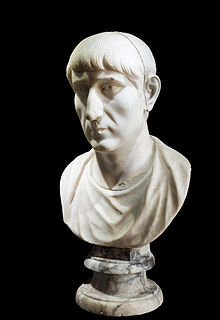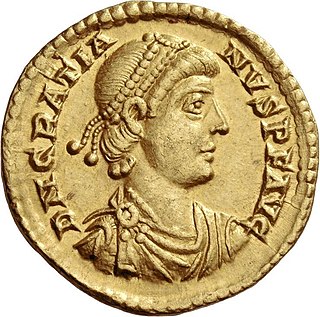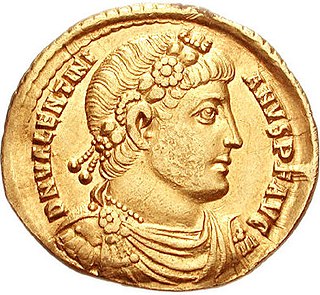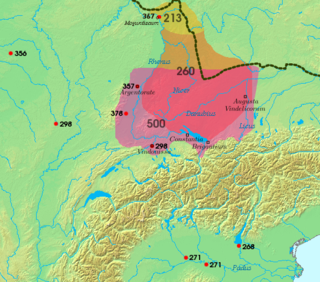
Flavius Julius Constantius, known as Constantius II, was Roman emperor from 337 to 361. His reign saw constant warfare on the borders against the Sasanian Empire and Germanic peoples, while internally the Roman Empire went through repeated civil wars, court intrigues and usurpations. His religious policies inflamed domestic conflicts that would continue after his death.

Julian was Roman emperor from 361 to 363, as well as a notable philosopher and author in Greek. His rejection of Christianity, and his promotion of Neoplatonic Hellenism in its place, caused him to be remembered as Julian the Apostate in Christian tradition.

Flavius Valens was Roman emperor from 364 to 378. He was the younger brother of the emperor Valentinian I, who gave Valens the eastern half of the Roman Empire to rule. Before 364, Valens had a largely unremarkable military career. In 378, Valens was defeated and killed at the Battle of Adrianople against the invading Goths, which astonished contemporaries and marked the beginning of barbarian encroachment into Roman territory.
The 360s decade ran from January 1, 360, to December 31, 369.

Gratian was emperor of the western part of the Roman Empire from 367 to 383. The eldest son of Valentinian I, Gratian accompanied his father on several campaigns along the Rhine and Danube frontiers and was raised to the rank of augustus in 367. Upon the death of Valentinian in 375, Gratian took over government of the west while his half-brother Valentinian II was also acclaimed emperor in Pannonia. Gratian governed the western provinces of the empire, while his uncle Valens was already the emperor over the east.

Valentinian I, sometimes called Valentinian the Great, was Roman emperor from 364 to 375. Upon becoming emperor he made his brother Valens his co-emperor, giving him rule of the eastern provinces while Valentinian retained the west.

The Western Roman Empire comprises the western provinces of the Roman Empire at any time during which they were administered by a separate independent Imperial court; in particular, this term is used in historiography to describe the period from 395 to 476, where there were separate coequal courts dividing the governance of the empire in the Western and the Eastern provinces, with a distinct imperial succession in the separate courts. The terms Western Roman Empire and Eastern Roman Empire were coined in modern times to describe political entities that were de facto independent; contemporary Romans did not consider the Empire to have been split into two empires but viewed it as a single polity governed by two imperial courts as an administrative expediency. The Western Roman Empire collapsed in 476, and the Western imperial court in Ravenna was formally dissolved by Justinian in 554. The Eastern imperial court survived until 1453.

Flavius Claudius Constantius Gallus (326–354) was a statesman and ruler in the eastern provinces of the Roman Empire from 351 to 354, as Caesar under emperor Constantius II, his cousin. A grandson of emperor Constantius Chlorus and empress Flavia Maximiana Theodora, and a son of Julius Constantius and Galla, he belonged to the Constantinian dynasty. He was born during the reign of his uncle Constantine the Great, and was among the few to survive the killings of male members of the imperial family in 337. Under Constantius II, he married Constantina, Constantine's daughter and Constantius' sister. As Caesar he dealt with a Jewish revolt (351–352) and ruled from Antioch, but the emperor came to mistrust him, and ultimately had him executed and replaced with his younger half-brother Julian.

The Valentinianic or Valentinian dynasty was a ruling house of five generations of dynasts, including five Roman emperors during Late Antiquity, lasting nearly a hundred years from the mid fourth to the mid fifth century. They succeeded the Constantinian dynasty and reigned over the Roman Empire from 364 to 392 and from 421 to 455, with an interregnum (392–423), during which the Theodosian dynasty ruled and eventually succeeded them. The Theodosians, who intermarried into the Valentinian house, ruled concurrently in the east after 379.

The Battle of Strasbourg, also known as the Battle of Argentoratum, was fought in 357 between the Western Roman army under the Caesar Julian and the Alamanni tribal confederation led by the joint paramount King Chnodomar. The battle took place near Strasbourg, called Argentoratum in Ammianus Marcellinus' account, Argentorate in the Tabula Peutingeriana.

Petulantes was an auxilia palatina of the Late Roman army.
Barbatio was a Roman general of the infantry under the command of Constantius II. Previously he was a commander of the household troops under Gallus Caesar, but he arrested Gallus under the instruction of Constantius, thereby ensuring his promotion on the death of Claudius Silvanus. In 359, both he and his wife Assyria were arrested and beheaded for treason against Constantius, possibly as part of a plot by Arbitio, a senior cavalry commander, and another exponent of the forms of scheming and political intrigue that became such a part of the later Roman Empire.

The history of the Roman Empire covers the history of ancient Rome from the fall of the Roman Republic in 27 BC until the abdication of Romulus Augustulus in AD 476 in the West, and the Fall of Constantinople in the East in AD 1453. Ancient Rome became a territorial empire while still a republic, but was then ruled by Roman emperors beginning with Augustus, becoming the Roman Empire following the death of the last republican dictator, the first emperor's adoptive father Julius Caesar.
Chnodomar was the king of an Alamannic canton in what is now south-west Germany, near the Rhine from sometime before 352 till 357. He seems to have had a recognized position among the other Alamanni.

Byzantium under the Constantinian and Valentinianic dynasties was the earliest period of the Byzantine history that saw a shift in government from Rome in the west to Constantinople in the East within the Roman Empire under emperor Constantine the Great and his successors. Constantinople, formally named Nova Roma, was founded in the city of Byzantium, which is the origin of the historiographical name for the Eastern Empire, which self-identified simply as the "Roman Empire".
Nevitta was a Roman military leader and official in the Roman Empire. His career is closely linked to that of the emperor Julian. He was master of the cavalry and in 362 served as consul.
The restoration and tolerance of Paganism from Julian until Valens, from 361 till 375 was a brief period of relative tolerance towards Pagans, preceded by the persecutions of Constantius II and followed by those of Emperor Gratian.
Flavius Arintheus was a Roman army officer who started his career as a middle-ranking officer and rose to senior political and military positions. He served the emperors Constantius II, Julian, Jovian and Valens. He was appointed consul in 372 alongside Domitius Modestus.
Flavius Lupicinus was a Roman military commander in the 4th century AD.

Vadomarius was an Alemannic king and Roman general, who shared power with his brother Gundomadus. After instigating an indecisive campaign in Gaul against the Romans, Vadomarius and his brother signed a treaty with the Roman emperor Constantius II in AD 356. Encouraged by Constantius II, Vadomarius employed his Alemanni forces in an attack against Julian. Vadomarius then concluded a treaty with Julian, after which, he unsuccessfully attempted to play the two Roman figures against one another. When Julian was made aware of this, he arrested Vadomarius and banished him to Hispania. His son Vithicabius succeeded him as king. Later, Vadomarius allied himself with Rome under emperors Jovian and Valens, leading his forces against the usurper Procopius and fighting the Persians on Rome's behalf.